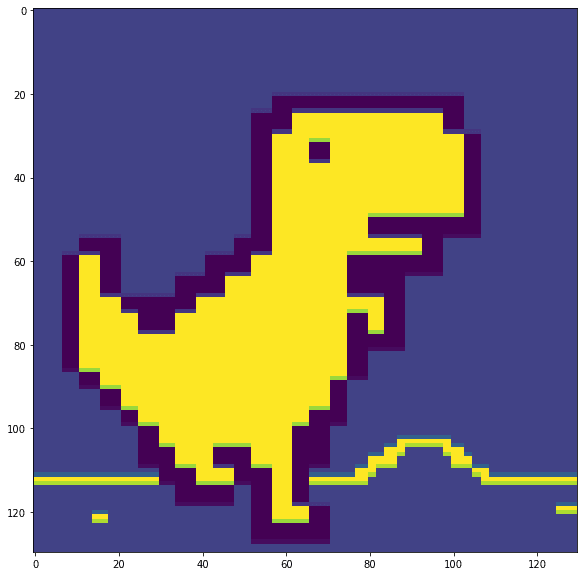27
Day4: Playing Trex Game on Chrome using Image Processing
Hello everyone, in the last part, we used gestures to perform jump and duck but in this part, we will not use gestures. We will use only some image processing techniques and then let the code play it. But our code will not be any kind of Machine Learning code or algorithms.
This blog is the part of the series #7DaysOfComputerVisionProjects. Links to the blogs and videos of each projects are:
We have used everything imported in this code here except
pyautogui please install it using pip install pyautogui. We will use it for getting the screenshot of our screen.import pyautogui
import numpy as np
import tkinter as tk
import cv2
import matplotlib.pyplot as plt
import keyboarddef show(img, fsize=(10,10)):
figure=plt.figure(figsize=fsize)
plt.imshow(img)
plt.show()
show(np.random.randint(0, 255, (100, 100)))
root = tk.Tk()
screen_width = root.winfo_screenwidth()
screen_height = root.winfo_screenheight()
ssize = (screen_height, screen_width)
ssize(768, 1366)In this project, we will do background subtraction for checking if any object is coming ahead. So, first I took a screenshot of my dino game then saved it on my project directory.

Then I extracted the portion where dino lies, seems like it lies between row 370 to 500 and column 50 to 180. Another 2 things we need is ROIs for checking bottom part and top part. I named
broi for bottom and troi for top. Once cropped these parts, show them.game_window = cv2.imread("chrome_dino.png", 0)
show(game_window, (15, 15))
brr1,brr2,brc1,brc2 = 370, 450, 160, 580
trr1,trr2,trc1,trc2 = 170, 370, 160, 600
troi = game_window[trr1:trr2, trc1:trc2]
broi = game_window[brr1:brr2, brc1:brc2]
dino = game_window[370:500, 50:180]
show(dino)
show(broi, fsize=(15, 15))


resolution = ssizelive where we will make our screenshot live. Also resize it.
cv2.namedWindow('live', cv2.WINDOW_NORMAL)
cv2.resizeWindow("live", 480, 270)fc for frame count and increase_every as threshold to increase ROI in ever that frame.
fc = 0
increase_every = 7while True:img = pyautogui.screenshot()frame = np.array(img)
gframe = cv2.cvtColor(frame, cv2.COLOR_BGR2GRAY)frame_roi as ROI from each frame and broi as ROI from default image.
frame_roi = gframe[brr1:brr2, brc1:brc2]
broi = game_window[brr1:brr2, brc1:brc2]res = cv2.matchTemplate(gframe, dino, cv2.TM_CCOEFF_NORMED)
th = 0.5
w, h = dino.shape
loc = np.where(res>=th)if len(loc[0]>=1):if fc==increase_every:
fc = 0
brc2 += 1
print("Increased brc2 to: ", brc2)
if brc2>resolution[1]:
brc2=resolution[1]
broi = game_window[brr1:brr2, brc1:brc2]
frame_roi = gframe[brr1:brr2, brc1:brc2]broi and frame_roi. If the value is true, then we find absolute difference and then apply strict normalization. Which simply tells us that the similar parts will be 0 in the result and dissimilar will be 255.
if np.abs(loc[0].max()-370)<=20:
diff = cv2.absdiff(frame_roi.astype(np.float32), broi.astype(np.float32)).astype(np.uint8)
diff[diff<50] = 0
diff[diff>=50] = 255if (diff==255).sum() > 100:
keyboard.press_and_release("space")
fc+=1
cv2.imshow("diff", diff)else:
brr1,brr2,brc1,brc2 = 370, 450, 160, 520cv2.imshow("live", frame)
if cv2.waitKey(1) &0xFF == 27:
break
cv2.destroyAllWindows()game_window = cv2.imread("chrome_dino.png", 0)
show(game_window, (15, 15))
brr1,brr2,brc1,brc2 = 370, 450, 160, 520
trr1,trr2,trc1,trc2 = 170, 370, 160, 600
troi = game_window[trr1:trr2, trc1:trc2]
broi = game_window[brr1:brr2, brc1:brc2]
dino = game_window[370:500, 50:180]
# show(dino)
# show(roi, fsize=(15, 15))
resolution = ssize
cv2.namedWindow('live', cv2.WINDOW_NORMAL)
cv2.resizeWindow("live", 480, 270)
fc = 0
increase_every = 7
while True:
img = pyautogui.screenshot()
frame = np.array(img)
gframe = cv2.cvtColor(frame, cv2.COLOR_BGR2GRAY)
frame_roi = gframe[brr1:brr2, brc1:brc2]
broi = game_window[brr1:brr2, brc1:brc2]
res = cv2.matchTemplate(gframe, dino, cv2.TM_CCOEFF_NORMED)
th = 0.5
w, h = dino.shape
loc = np.where(res>=th)
#print(loc)
if len(loc[0]>=1):
game_stat = "start"
if fc==increase_every:
fc = 0
brc2 += 1
print("Increased brc2 to: ", brc2)
if brc2>resolution[1]:
brc2=resolution[1]
broi = game_window[brr1:brr2, brc1:brc2]
frame_roi = gframe[brr1:brr2, brc1:brc2]
if np.abs(loc[0].max()-370)<=20:
diff = cv2.absdiff(frame_roi.astype(np.float32), broi.astype(np.float32)).astype(np.uint8)
diff[diff<50] = 0
diff[diff>=50] = 255
if (diff==255).sum() > 100:
keyboard.press_and_release("space")
fc+=1
cv2.imshow("diff", diff)
else:
game_state="pause"
brr1,brr2,brc1,brc2 = 370, 450, 160, 520
cv2.imshow("live", frame)
if cv2.waitKey(1) &0xFF == 27:
break
cv2.destroyAllWindows()
Increased brc2 to: 521
Increased brc2 to: 522
Increased brc2 to: 523
Increased brc2 to: 524
Increased brc2 to: 525
Increased brc2 to: 526
Increased brc2 to: 527
Increased brc2 to: 528
Increased brc2 to: 529
Increased brc2 to: 530
Increased brc2 to: 521
Increased brc2 to: 522
Increased brc2 to: 523
Increased brc2 to: 524
Increased brc2 to: 525
Increased brc2 to: 526
Increased brc2 to: 527
Increased brc2 to: 528
Increased brc2 to: 529
Increased brc2 to: 530
Increased brc2 to: 531
Increased brc2 to: 532
Increased brc2 to: 533
Increased brc2 to: 534
Increased brc2 to: 535
Increased brc2 to: 536
Increased brc2 to: 537This is all for this part and I have not written a code for ducking part. I hope you can try that feature on your own. If you found some errors or problems please let us know.
27
